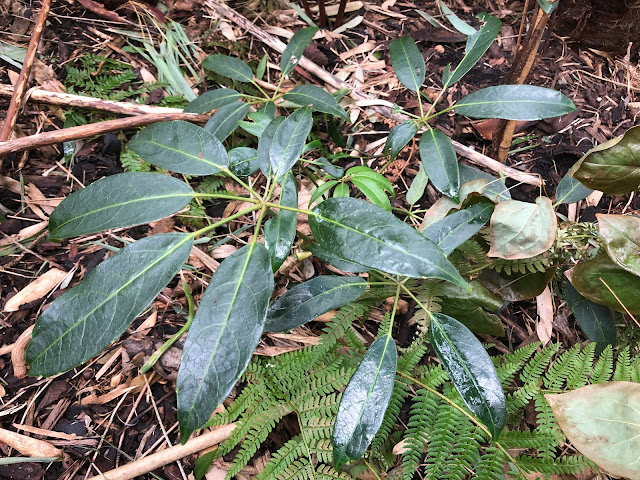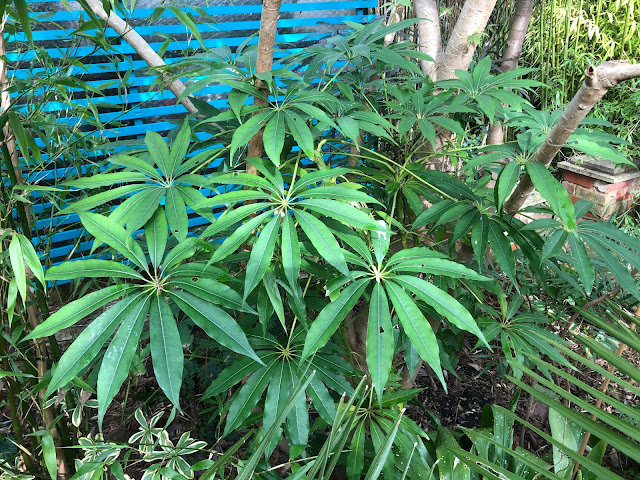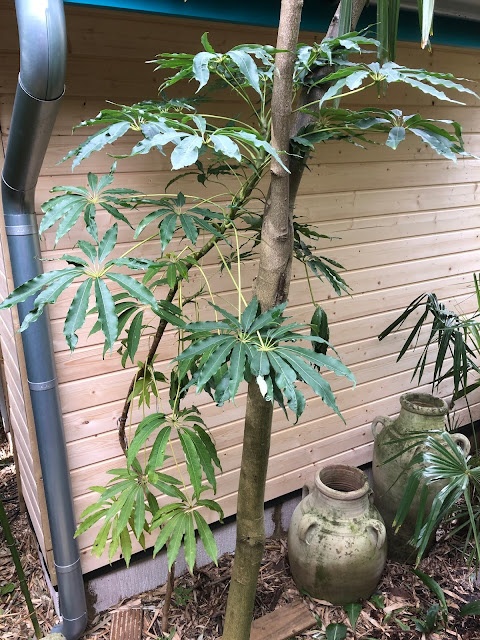 |
| Schefflera taiwaniana |
There is much debate currently as to the correct nomenclature for much of the genus - Heptapleurum being the suggested correct name. For the purpose of this post we will stick with Schefflera, but feel free to shout at the screen that we are incorrect!
Looking back at some of our old posts, such as this one from 2014 I am amazed by some of the growth we have seen.
 |
| 2014 - Schefflera rhododendrifolia on the middle patio |
 |
| The same plant today - harder to photograph |
This Schefflera rhododendrifolia is probably the longest grown in our garden, not the oldest we have, I'll come on to that later. It came back with us from a trip to Cornwall and has sailed though British winters for a good 12 years or more. Its a good 3.5m to 4m tall now (13feet or so) and has been sending out a number of shoots from nearer the base over the last few years. Its growing in a fairly free draining clay soil, and probably benefits from the taller bamboo canopy behind it. Despite having seen some tough winters (-10C and a week of sub zero temperatures back in 2010) its never shown any sign of distress or damage from cold.
Schefflera rhododendrifolia does seem to have significant variability, this form by the Koi pond, came as a rooted cutting from Tom Hudson at Tregrehan.
Its growing in a raised bed filled with the spoil from digging the koi pond - so again clay, but reasonably free draining. This year it has produced a large amount of berries, which were not affected by the recent cold - unlike some berries on other Schefflera.
 |
| Schefflera rhododendrifolia berries |
Another Schefflera rhododendrifolia also with berries, is the "Garden House" form. So called as much of the seed/cutting material used to propogate a few years ago came from a plant at The Garden House in Devon (sadly the parent plant has subsequently died). This seems to be the most commonly availably S. rhododendrifolia we have noticed in nurseries in the UK, and has foliage much closer to that of a typical Rhododendron.
 |
| Schefflera rhododendrifolia (Garden House) in 2014 |
I said earlier that I would come back to the oldest Schefflera we have, which is a S. taiwaniana. This was bought from a fellow gardener that was moving home and unable to take many of his plants with him. We had to dig it up and initially re-establish in a pot before planting in its current position. It has an extremely open and spreading habit, especially when compared to the more upright forms of S. rhododendrifolia in our garden.
This has also proved a tough plant, showing no ill effects from its removal, and first winter in a pot, before seeing some fairly hard winters back in 2010, 2011. Another one that is now hard to take a photo of in our rather packed garden.
We have noticed with S. taiwaniana that rooted cuttings often behave slightly strangely, wanting to grow more like a branch rather than forming a strong lead shoot. This seems to give them a scrambling habit which can be frustrating.
This one on by the house is supported by a stake currently, as it just wants to grow along the patio.
Finally in the area we nickname "the former small pond area" there is a S. taiwaniana and S. rhododendrifolia competing for attention. In the lower foreground I am attempting to air layer this plant - although with very limited success so far. If you have had any success with this then please share your tips in the comments.
Another Schefflera that also featured in that 2014 post was S. aff. myriocarpa. This has branched and creates quite a nice canopy as you enter the main part of the garden.
 |
| Schefflera aff. myriocarpa in 2021 |
 |
| Schefflera aff. myriocarpa today |
A recently planted Schefflera shweliensis from Pan Global Plants. Will be looking forward to seeing how this one does in the coming years. This one comes from the Eastern Himalaya and these were found in Nagaland, NE India. This one is a fairly recently introduction, so will be good to see how it performs. A week of close to freezing temperatures and an absolute low of -5C hasn't caused any noticeable problems for our plant.
Schefflera delavayi is an old favourite of ours. We have found it a little less hardy than the others we grow, having lost an established plant to a normal winter a few years ago. However undeterred we have grown on and planted out another, this time in a very sheltered spot close to the Jungle Hut.
 |
| Schefflera delavayi |
 | |
|
With my hand for scale, when happy Schefflera delavayi have fabulously large glossy leaves.
Schefflera kornasii came from Crug Farm, from a seed collection from the mountain of Fan Xi Pan, in northern Vietnam, in 2006 at around 2500m, where it grew on a small ridge within the steep forest.
 |
| Schefflera kornasii |
Our Schefflera kornasii has some shelter and has so far proved hardy in our location.
 |
| Schefflera alpina |
Schefflera alpina, recently planted in 2020 but expected to do well in our location. Hopefully will be able to share positive updates on this one in the future.
 |
| Schefflera fantsipanensis |
 |
| Schefflera gracilis x taiwaniana |
Schefflera gracilis x taiwaniana has been in this spot for several years, fairly sheltered by the jungle hut it has grown rather leggy with a branches over the top of the building that gave it shelter as a young plant. However it is now branching lower down so hopefully will fill out and reach its potential.
I have no doubt forgotten one or two others in the garden, but they will have to wait for another day!
Gaz










 This gardening blog follows our journey as we create our Tropical and Exotic themed garden. We hope you'll enjoy the journey as much as we do. We started our Exotic Garden in 2005 and this site will show its development, as well as our travels, both abroad and within the UK to gardens, nurseries and friends.
This gardening blog follows our journey as we create our Tropical and Exotic themed garden. We hope you'll enjoy the journey as much as we do. We started our Exotic Garden in 2005 and this site will show its development, as well as our travels, both abroad and within the UK to gardens, nurseries and friends.













This post supports my memory of your garden as a schefflera wonderland. I've still got only three, S. brevipedunculata, S. delavayi and S. taiwaniana.
ReplyDeleteGreat memories, hopefully you can visit again one day soon :) fine selection you have already!
DeleteSchefflera, the stuff of dreams for me. Availability is pretty much limited to small specialist nurseries. In addition, I don't think they'd like the summer-dry Mediterranean climate here in California too much.
ReplyDeleteBut when I see a post like yours, it makes me realize that I could grow all kinds of cool plants if I found myself living in a less temperate climate.
Ahh but look at all the aloes you can grow :)
DeleteI'm envious. I'd always thought of Scheffleras as house plants until I saw yours, as well as some of the huge specimens grown in the Pacific Northwest. As Gerhard noted, even now I rarely seen them grown outside in my own climate, although I do remember one growing immediately outside my neighbor's apartment when we lived in Santa Monica - I couldn't tell you the species but I remember how impressed I was by it. Santa Monica gets favorable ocean breezes and is probably at least 20 degrees (Fahrenheit) cooler on average during the summer than we are (even though I can see the ocean from my window).
ReplyDeleteI wonder how well the houseplant types will do planted out in your area, the S. arboricola and S. actinophylla. Might be worth a try :)
DeleteDarlings,
ReplyDeleteWhat a glorious collection of Scheffleras you have in your garden. They seem to have grown very well over the years and they add such wonderful foliage effects and textures to the planting schemes. the hardiness is surprising to us but you are most probably giving them just the conditions they need to thrive and are obviously tending them with care.
Your mention of 'Crug Farm' brought back happy memories of adventures to that most wonderful plant nursery. Our purchases from there in our gardening days centred around any number of rare plants including trilliums and erythroniums, but they do have a remarkable collection of treasures to choose from. We are delighted to see that they are still going strong.
Thanks Jane and Lance! Crug is going from strength to strength and such a treasure throve of plant gems they have
Delete